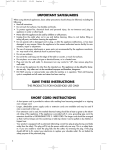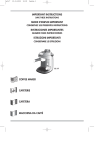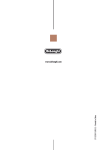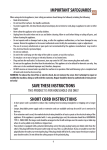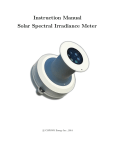Download Coffee Machine
Transcript
bar 4/5732101400 9-06-2000 9:41 Pagina 1 Coffee Machine Instructions for use bar 4/5732101400 9-06-2000 9:41 Pagina 2 DESCRIPTION OF THE APPLIANCE A. B. C. D. E. F. 2 Water tank Tank cap Steam knob Steam tube with cappuccino nozzle Power cable Drip tray G. H. I. J. Carafe with lid Filter holder Filter Measuring spoon K. ON/OFF Switch bar 4/5732101400 9-06-2000 9:41 Pagina 3 3 bar 4/5732101400 4 9-06-2000 9:41 Pagina 4 bar 4/5732101400 9-06-2000 9:41 Pagina 5 Please read this instruction booklet carefully before installing the appliance and keep it handy for future consultation. In so doing you will obtain the best result and maximum safety in its use. INSTALLATION - Position the appliance on a level surface away from faucets and wash basins. - Make sure the power supply corresponds to that specified on the appliance’s data plate. Only connect the appliance to a power socket which has a minimum load of 10A and which is efficiently earthed. - In the event of the socket being incompatible with the plug on the appliance, have the plug replaced with a suitable one, by qualified professional staff. - The electrical safety of the appliance is ensured only when the latter is properly and efficiently earthed. If in case of doubt, ask a qualified professional. - Do not install the appliance in rooms that may reach temperatures of or below 0°C (as freezing may cause damage). SAFETY INSTRUCTIONS - Do not immerse the appliance in water. - Do not operate the appliance without first having water in the tank. - Do not fill the water tank with milk. - Be careful not to scald yourself with spouts of water or vapour or by using the appliance incorrectly and do not touch hot parts (water, dispensing area in contact with the filter-holder and filter). - Do not remove the filter-holder while the appliance is under pressure or dispensing. - Once the packaging has been removed, check that the appliance is in full working order. If in doubt, do not use the appliance and contact qualified service staff. - Packaging materials (plastic bags, foam polystyrene , etc.) should not be left within reach of children as they could be a potential source of danger. - This appliance is for domestic use only. Any other use is to be considered improper and therefore dangerous. - Do not touch the appliance when hands or feet are wet or damp. - Do not allow children or irresponsible people to operate the appliance. - Installation must be carried out according to the manufacturer’s instructions. - The appliance’s power-cable must not be replaced by the user as special tools are required in order to replace it. In the event of damage to the cable, or if the cable needs replacing, contact only the nearest after-sales assistance centre authorised by the manufacturer. - Materials and objects that are to come into contact with foodstuffs are in accordance with w hat set for t h b y E EC dire c tiv es 89/109. PREPARING EXPRESSO COFFEE 1 Remove the boiler cap by turning it anticlockwise. 2 Using the carafe supplied (fig. 1) pour water into the boiler (fig. 2) according to the amounts shown in the table at the end of the text. Do not exceed the amounts shown as this could cause the appliance to malfunction. While filling the boiler make sure the ON/OFF switch is in the OFF position. 3 Carefully close the boiler cap by turning it clockwise. 4 Insert the filter into the filter-holder. (fig. 3). 5 Put the coffee evenly into the filter according to the amounts shown in the table following (fig. 4). It is important to use medium ground coffee. (Avoid using too finely ground coffee otherwise the filter could become blocked, MOKA coffee is suitable). 6 Remove excess coffee from the filter rim (fig. 5). 7 To attach the filter-holder to the machine place the filter holder under the heater-faucet (fig. 6) and line up with the arrow marked 5 bar 4/5732101400 9-06-2000 9:41 Pagina 6 on the machine lid (fig. 7). At this point press filter-holder upwards while at the same time rotating clockwise all the way. It does not matter if the filter housing bowl’s handle is not centrally aligned with the machine. It is important that the bowl be firmy set in its housing. 8 The carafe with the lid must be positioned under the filter holder so that the spout is inside the opening on the carafe’s lid (fig. 8). Make sure that the steam knob is turned off. 9 Insert the plug and press the power switch.The indicator will come on (fig. 9). 10 About three minutes are required before the coffee begins to be discharged. Turn off power switch after coffee has been discharged. 11 Before unscrewing the boiler cap or removing the filter holder, residual pressure must be released by slowly turning the steam knob (fig. 11) so that the residual steam can escape. Note: for safety reasons, it is not possible to open the boiler cap when the boiler is hot as the cap turns without unscrewing. If it has to be removed for any reason, it is always necessary to let off steam from the boiler using the steam knob as described immediately above. • To remove coffee grounds from the filter holder, turn upside down and knock it repeatedly until all grounds have been removed (fig. 11), or rinse the filter holder unit under running water and let drip dry. NOTE To eliminate the “new” smell, the first time you use the coffee machine, carry out a number of coffee cycles without using coffee. MAKING CAPPUCCINO A cappuccino is an espresso coffee with a froth topping made by heating milk. 1 Using the following table as a guide pour the required amount of milk into carafe. The best results will be achieved using fresh milk, not skimmed, which should be at refrigerator temperature. 2 Transfer the milk into a jug. The jug should be large enough to allow the milk to expand to around treble its volume. 6 3 Then follow steps 1-9 in the section "Making Espresso Coffee". N o t e that the amount of water needed to make 2 cups of cappuccino is greater than that required for 2 cups of normal coffee as it also necessary to produce the steam to emulsify the milk. 4 When the coffee starts to drip from the filter holder, place the steam nozzle in the milk (fig. 12) ensuring that the nozzle opening is just under the surface of the milk, as shown in fig. 13 and open the steam valve by turning the steam knob counter clockwise. 5 Move the jug up and down under the steam nozzle as in fig. 14 (this will give maximum froth). When sufficient milk froth has been produced, turn the steam knob clockwise to close the steam valve. 6 Allow the remaining coffee to drip thorugh the filter holder into the carafe, it takes about 3 minutes,the n swit ch the ap pliance OFF. Remember: Before unscrewing the tank tap or removing the filter holder, residual pressure must be released by slowly turning the steam knob so that the residual steam can escape. 7 Pour the coffee into cups, gently pour, or preferably spoon the frothy milk onto the coffee, then sprinkle on a little chocolate powder for perfect cappuccino coffee. 8 Clear the steam tube (with the cappuccino nozzle) of milk immediately after use, as dried milk can be difficult to remove. Remember: You do this by turning the steam control knob counter clockwise. Than making care as the steam tube may be hot: • unscrew the cappuccino nozzle by turning gently to the left (fig. 15) and wash it carefully in hot water. • clean the steam tube and replace the cappuccino nozzle. (from time to time, use a pin to clean the holes in the cappuccino nozzle (fig. 16). bar 4/5732101400 9-06-2000 9:41 Pagina 7 HINTS DESCALING Making good espresso and cappuccino is not difficult however it does require practice. The following tips will help you get the best results from your machine: • Warm the cups before filling with coffee. If you live in a hard-water area, minerals and calcium found in the water will accumulate and affect the operation of the machine. Approximately every six months (depending on the hardness of the water), your espresso maker should be cleaned with vinegar as follows: 1. Before cleaning your espresso maker, turn the switch to OFF and remove the plug from the wall socket. 2. Fill the carafe with vinegar and pour into the water tank. 3. Replace the boiler cap. 4. Fit the filter and filter-holder (without any coffee). 5. Place the carafe on the drip tray. 6. Insert the plug into the wall socket. 7. Turn the switch to ON. After a few minutes, the hot vinegar will begin to flow through the filter-holder into the carafe. 8. Place the steam tube in a glass or mug. Open the steam knob for a few seconds while the vinegar flows through the filter-holder. This will clear any milk residue from the inside of the tube. 9. Turn on the steam knob (the vinegar will continue to flow into the carafe). 10.When no more vinegar flows into the carafe, turn the switch to OFF and allow the machine to cool. Remove the filter-holder, the filter and the carafe and rinse with hot water. 12.Repeat the last two steps using cold water in order to remove any residual vinegar. Repeat twice. • Use a dedicated espresso coffee for best results. They are now widely available from supermarkets. • Freshly ground coffee provides the best flavour. To maintain flavour, fresh coffee is best stored in an airtight container in a cool place, even in the fridge. CLEANING AND MAINTENANCE • • • • • Before carrying out any cleaning or maintenance, switch the machine off, remove the plug from the socket and leave the machine to cool. Do not use solvents, detergents or abrasive products to clean the machine. A soft damp cloth is sufficient. Clean the filter-holder, filter and drip tray regularly. Do not wash the machine in water - remember that it is an electrical appliance. Never wash components or accessories in a dishwasher. 7 bar 4/5732101400 9-06-2000 9:41 Pagina 8 ELECTRICAL CONNECTION (UK ONLY) A) If your appliance comes fitted with a plug, it will incorporate a 13 Amp fuse. If it does not fit your socket, the plug should be cut off from the mains lead, and an appropriate plug fitted, as below. WARNING: Very carefully dispose of the cut off plug after removing the fuse: do not insert in a 13 Amp socket elsewhere in the house as this could cause a shock hazard. With alternative plugs not incorporating a fuse, the circuit must be protected by a 15 Amp fuse. WARNING - THIS APPLIANCE MUST BE EARTHED IMPORTANT The wires in the mains lead are coloured in accordance with the following code: Green and yellow: 8 Earth Blue: Neutral Brown: Live 5732101400/01.98 B) If the plug is a moulded-on type, the fuse cover must be re-fitted when changing the fuse using a 13 Amp Asta approved fuse to BS 1362. In the event of losing the fuse cover, the plug must NOT be used until a replacement fuse cover can be obtained from your nearest electrical dealer. The colour of the correct replacement fuse cover is that as marked on the base of the plug. If your appliance is not fitted with a plug, please follow the instructions provided below: As the colours of the wires in the mains lead may not correspond with the coloured markings identifying the terminals in your plug, proceed as follows: The green and yellow wire must be connected to the terminal in the plug marked with the letter E or the earth symbol or coloured green or green and yellow. The blue wire must be connected to the terminal marked with the letter N or coloured black. The brown wire must be connected to the terminal marked with the letter L or coloured red.








